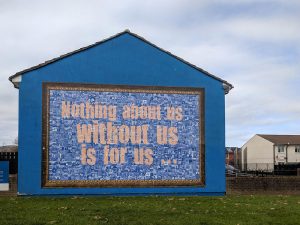
PHOTOGRAPH: “CASTILLO” BY SKIP HUNT
Editors’ note: This article was first published in the Nonprofit and Voluntary Sector Quarterly, in June 2004, and is featured in NPQ‘s special winter 2012 edition: “Emerging Forms of Nonprofit Governance.”
Much of the dialogue around nonprofit boards has focused on secondary or transactional issues rather than on the question of what good governance must include in a nonprofit setting. This serves to rob the nonprofits of creativity, rigor, power, and the kind of finely tuned understanding of accountability the public should expect. By focusing on the central questions and principles of nonprofit governance rather than on structural concerns, the possibilities for a wider variation in governance models open up. All organizations are set in a larger social context, so we cannot end our reflection at the individual nonprofit level. These questions are particularly pertinent during a period when our attention is focused on governance from Wall Street to Baghdad. Some believe that public governance is overly affected by corporate interests, and we are now seeing case after case of scandals exposing ethical problems in the governance of corporations that only recently were seen as exemplary. This puts the interests of ordinary and particularly marginalized people at risk. In a democracy, the nonprofit sector is there to ensure that people have a voice in our future—at the community, national, and global levels. If we accept this as our primary role, it has implications for what should be present as constants in our governance structures.
Are nonprofit institutions acting in ways that respect, and are open to the intellect and creativity of, the people they are established to benefit? If not, what are we inadvertently putting at risk? Have we made ourselves party to a larger problem of democratic deficit in this country by too often squatting ineffectually in the place needed for its revival? I think nonprofit leaders are increasingly missing the point of nonprofit governance and, as a result, functioning without the power and influence we might otherwise have.
A Quantum Leap Regarding the Possibilities
On a gray day in December, a group of civil servants sat around a gray, windowless room in a government building in Northern Ireland. The biscuits were packaged, the tea was tepid, but the conversation was, as they say, “absolutely brilliant.” The participants in this conversation were functionaries in the Department of Culture and Leisure, one of eleven ministries in the new, shared government. I was there to help debrief them on their use of Future Search,1 a highly inclusive planning process they had been using to suss out the resource-, policy-, and system-change needs of whole fields of endeavor (in their case, everything from soccer and libraries to archives, arts, and culture). The process attempts to bring the whole system into the room in order to have conversations about the future of the thing about which all have passion and concern. Participants seek out the best way forward and envision a different future that will involve all of them in its realization.
In the process, they began to see the practice, and potential, of governance differently. “To tell you the truth,” one middle-aged man commented, “for the first time in my experience, this has given government the extraordinary opportunity to be on the same page as the people that it governs.” What a powerful moment that was, summing up the cognitive dissonance sitting smack in the middle of our democratic system of governance.2 The woman who had introduced Future Search into Northern Ireland’s devolved and newly democratic government was Aideen McGinley, herself a thirty-year civil servant. In the fall 2003 issue of the Nonprofit Quarterly, she commented on the ethical construct that motivated Future Search’s use:
Responsible governance at every level requires us to be the voice of the people we represent. This is not a charge that should be taken lightly. It requires us to take the time to enable people to tell and make meaning of their own stories, so others can act with them on their own behalf. The single most difficult issue we face globally is keeping people motivated. There is such disengagement and disillusionment about political systems and when people are disillusioned they will disengage.
When Governance Is the Message
More than a decade ago, I read and was deeply moved by an article called, “When Management is the Message,” by Thomas H. Jeavons. In it, he suggested that the general public was disheartened by a growing gap between the institutionally self-serving management interests of nonprofit organizations on one hand and the values embodied in our mission statements on the other. Reflecting on this gap, he wrote, “Perhaps it is because the American public has higher expectations of . . . nonprofit organizations. The fact is that, as consumers, we half expect to be taken occasionally, or at least disappointed by, for-profit firms trying to increase their profit margin at our expense, and as taxpayers we almost assume that large corporations will cheat the government when they think they can get away with it, but we fully expect—even demand—a higher level of integrity from charitable or philanthropic organizations. We tend to believe . . . that they should operate with different values and that greater integrity in their operation is something we have a right to expect.”
I would suggest that this faith is fast waning and that, if it disappears altogether, we will have no one to blame but ourselves. This time, it is not management that is eroding public confidence in the nonprofit sector but governance. And if we cannot restore the integrity of our governance systems, nonprofits will lose more than their reputations. As Jeavons said, nonprofits may find “the very existence of their organizations threatened, because the privileges and support on which they depend for survival could be withdrawn as the result of public disappointment.” At the very least, such erosion of our relationships with constituents will result in an increasingly institutionalized sector progressively more beholden to business and government interests.
Public disappointment is already palpable. You might say that, with regards to the recent spate of scandals about self-dealing among trustees of foundations, as a Boston resident I sit in the belly of the beast. A spotlight team from the Boston Globe has found a great deal of low-hanging fruit in its recent investigation of philanthropy’s miscreants. It is difficult to expect the general population to take the integrity of charitable institutions seriously when Paul Cabot Jr., the scion of a deceased local philanthropist known for his stereotypical Brahmin frugality, explained earnestly that he had to raise his salary as a trustee of the Paul and Virginia Charitable Cabot Trust to provide his wife with her expected $10,000 monthly allowance (“She seems to think it’s not enough, like most women,” he explained) and also, by the way, to cover $200,000 of expenses from his daughter’s wedding. This while the assets of the trust have plummeted and while its annual disbursements have generally hovered at less than half of his annual salary.
This changes the tone of the conversations that people have with one another about nonprofits. A cab driver recently snorted at me, “Sweet deal, huh?” after I responded to his question about what I did. This fully justified cynicism does not affect just foundations. It colors our ability to believe in the honor of a much wider set of nonprofit institutions that are critically important to the health of our democracy. Although the Cabot Trust story points to a lack of reasonable controls, this is only the tip of the iceberg of what I see as a crisis in the governance of nonprofits.
The Real Cost of a Governance Crisis: Weakened Democracy
Roger Lohmann has proposed that this sector’s true purpose is to provide the venues where people can become involved in the commons. I agree that this traditional chewy center of our identity is where our true distinction resides. The commons is elsewhere described as “the social and political place where things get done and where people derive a sense of belonging and have a sense of control over their lives.” Elaborating on how things get done, Lohmann argued that there are five characteristic dimensions of collaborative common action:
- Free and uncoerced participation;
- Common or shared purpose;
- Participation that involves a sense of mutuality;
- Jointly held resources or endowment; and
- Social relations that are characterized by justice or fairness.
In the end, consistently violating the public’s expectation that these characteristics are held and valued within our organizations is far worse than the theft of some cash by corrupt philanthropists.
Because the nonprofit activity people become involved in on a voluntary basis is often connected to something that matters to them at an emotional level, it has the potential of acting as an excellent training ground for any number of disciplines important to civil society and active democracy. It can, for instance, help people to understand first-hand what steps they might take to change circumstances that trouble them. This will likely provide them with enhanced knowledge and analytical skills about legislative and political systems, social history, media portrayal of issues that they care about, and a host of other topics. If they are learning about these things in the course of taking action that eventually produces results, the learning is robust and not only usable but also teachable by each person involved.
But although I often hear terms like civil sector, voluntary sector, and independent sector bandied about, with lots of aspirational language, I hear very little conversation about how the way nonprofits organize their own governance systems on a practical level accrues to the end result of citizen engagement in the commons. This seems to me to be a significant oversight—one that threatens to weaken participation in the commons. My belief is that most people are wise enough to eventually disengage from systems that disengage from them; engagement is not sustainable in any kind of an energetic way when it does not observe fully the mutuality principle mentioned above. Further, people are likely not only to disengage but to become cynical about the value of getting personally involved in civic life.
Sign up for our free newsletters
Subscribe to NPQ's newsletters to have our top stories delivered directly to your inbox.
By signing up, you agree to our privacy policy and terms of use, and to receive messages from NPQ and our partners.
Some of you may be excusing yourself from this conversation by this time, believing that I am only talking about nonprofits involved in organizing and social change. Not at all. I am talking about any group involved in a sphere of common-cause work—nonprofit hospitals, the local Bach society, the local Boy Scout troop. The governing body of any group organized to meet the needs of a particular grouping of people has a number of responsibilities we are not yet fully acknowledging.
Why Are We Replacing Furniture?
We’re not even responding to this other governance crisis in which citizens disengage from working in the commons. In a recent issue of the Nonprofit Quarterly, Gus Newport, who has been involved in both public sector and nonprofit governance, offered one example of how nonprofits can erode or build civic capacity. He told the story of an inner-city community in which urban blight had laid waste to the environment. Abandoned lots with toxic waste had replaced housing, parks were unsafe for children, and the streets were unsafe for all. At some point, a funder visited one of the local nonprofits to respond to a request for furniture. He caught sight of a map of the community and asked what all of the blacked out areas were. Upon hearing that they represented abandoned property, he asked, “We come out here to award a grant to replace some worn furniture when half the neighborhood is missing?”
This community was certainly populated with its share of nonprofits. But, as Newport related, in not advocating for meaningful change through common strategies and rigor, these nonprofits had become party to the ongoing poor condition of the community. Where were the boards of these organizations? Were they asleep at the helm? Did they not take their responsibilities seriously enough to evaluate the conditions that their nonprofit organizations were charged with correcting?
Our public expects much of us—at least more than allowing our operations to become institutionalized in a way that limits their freshness, their edginess, and their effectiveness and that puts institutional interests ahead of constituent ones. This may lead nonprofits to act in isolation from obviously necessary partners. As Jeavons argued, “An organization may operate in a manner that is completely above board and beyond reproach but fail to see how its specific mission relates to other issues bearing on the public good.” Newport talked about this in his vivid example:
The area served by DSNI [the Dudley Street Neighborhood Initiative] was already served by a number of nonprofits, divided up by issue area—housing, youth work, labor and job training, multiservice centers, childcare, etc., by ethnic group and even by a combination of organizational histories. Despite the existence of all of these groups the area was a picture of urban devastation.
Eventually, the foundation that came out to replace the furniture offered to finance a full-scale effort to rejuvenate the neighborhood. But the residents resisted the idea of any of the local nonprofits acting as lead. This, Newport said, “tells us something about the disconnect between these organizations and the people they served—and tells us something about local boards’ lack of stewardship.” The Dudley Street Neighborhood Initiative was eventually developed to facilitate planning and organizing among the residents who controlled the organization. The results are striking: “Vacant lots have been transformed into 440 new homes, a town common, gardens, urban agriculture, parks and playgrounds, and 500 housing units have been rehabbed. Business is growing and the rebuilding continues today.” Newport’s governance example emphasizes the disciplines of inclusion, transparency, continuous leadership development (to ensure increasingly skilled engagement from constituents), rigor in planning, and active networking to ensure that strategies chosen are both highly leveraged and supported. This stands in some contrast to the usual vision of what nonprofit boards can and should do. Rather than focus on the larger, constituent-driven purposes that Newport urged, consultants and researchers have encouraged a more narrow focus in which boards’ work is about organizational controls and resource development. I would liken this to replacing furniture: It is a pretty unimaginative and constrained approach to a situation full of need and potential. As Bill Ryan, Richard Chait, and Barbara Taylor pointed out in their wonderful article “Problem Boards or Board Problem?,” “We can approach the problem of purpose in two ways. We can attempt to expose the board as an irrelevant institution constructed around a set of hollow roles and responsibilities. Or, as we prefer, we can ask whether the purposes now ascribed to boards might be necessary, but insufficient, to sustain engaged and effective service.”
Accountability: Engagement, Rigor, and Integration of the Issues
Although we have been spending time and ink on how to get boards to be minimally involved in the stuff that counts to our organizations, our communities and constituents have been falling out of love with us. And who is to blame them? We are not paying the right kind of attention to them in the relationship. As we set our direction, we should be in broad and deep consultation and engagement with them, so that, as that Northern Ireland civil servant said, we can be assured of being on the same side of the fence with them. This requires that we be inclusive of those who should be beneficiaries of our work. Because we want to be affected by their hopes and dreams, our processes for their inclusion in planning and evaluation, in the development of their analysis of the barriers and opportunities to the work, should be sophisticated and a central focus of governance.
Additionally, we should be as analytical as possible about the source points of problems limiting or even tormenting the populations of people we work with. And we should be rigorous enough to work with them to choose an intervention that promises real, sustainable relief from systemic problems and an improved long-term future. This means that our boards should be attentive to any research going on in their fields of endeavor as well as in other fields that affect their work. Our boards should be attentive to our public policy context and to opportunities to really collaborate toward higher level solutions than exist now. Dudley Street Neighborhood Initiative, for instance, was able to obtain eminent-domain power over the neighborhood’s empty lots, thereby providing the residents with remarkable control and leverage in development planning.
Awe-Inspiring Potential in Governance Reform?
“Active citizenship is a means by which we can all participate in shaping the society in which we live.” In Silent Theft: The Private Plunder of Our Common Wealth, David Bollier talked about the commons (our job, remember?) as being flexible yet hardy precisely because it draws information from everyone in a “bottom-up” flow. This means the rules are “smarter” because they reflect knowledge about highly specific, local realities. Inclusive decision making is more likely to be responsive and tailored to actual realities. The effectiveness of collective decision making in a commons is not really surprising. Rules informed by popular participation are more likely to have moral authority because everyone affected by the rules has had a say in formulating them.
Bollier went on to promote collective participation and decision making as behaviors that lead to a high capacity to adapt and sustain collective effort because they provide such rich feedback from such diverse sources. It is the responsibility of local nonprofits—if they are serious about representing and responding to constituent interests—to have governance mechanisms that can convene the individuals they are established to serve with other stakeholders, engage them in dialogue with the organization and one another, develop a collective dream of the future or vision of what can be accomplished, and develop strategies that will take the group from here to there. In doing this, the organization must help participants understand historical, social, and political issues that affect the situation. This helps each participant be a more active democratic agent. It allows for messages to move powerfully from the individual to the collective and from the local to the regional to the national consciousness.
If all of us in the nonprofit sector were to really take this seriously as our own unique role, if we were to claim it and fully exploit it, we might find a way to profoundly alter the current priorities of government, rehumanizing and lending a depth of agreed-upon values to what now passes as political discourse. Nonprofit boards in their styles of governing could provide a model for a more active and inclusive democracy. They could promote civic learning and they could be the avenues for the rich intelligence that flows from local to national engagement in public life. But we would need to look at our roles differently. We would need to see ourselves as facilitators not only of highly effective action within the realms of our own mission purviews but of a renewed and improved democracy at the national level. Perhaps it is time to take up as an entree a more energetic and purposeful discourse about the reform of nonprofit boards—one that might change how we think about the sector’s role in democracy and its power and influence overall.
Notes
- For more information, see www.futuresearch.net.
- Participants in the meeting cited other benefits of inclusive planning, including increases in “social capital—because it helps participants clarify their own position,” “spirals the power of formerly low-power groups,” “lets us get a more layered analysis,” and “creates a pressure cooker of creativity.”
References
Bollier, D. 2003. Silent Theft: The Private Plunder of Our Common Wealth. New York: Routledge.
Ecologist. 1993. Whose Common Future? Reclaiming the Commons. London: Earthscan Publications.
Government of Western Australia, Department of the Premier and Cabinet, Citizens and Civics Unit. 2003. A voice for all: Strengthening democracy. Western Australia Citizenship Policy.
Healy, B., Latour, F., Pfeiffer, S., and Rezendes, M. 2003. “Some officers of charities steer assets to selves.” The Boston Globe, October 9, 1.
Jeavons, T. 1992. “When Management Is the Message.” Nonprofit Management and Leadership 2(4): 403–416.
Lohmann, R. A. 1992. The Commons: Perspectives on Nonprofit Organization and Voluntary Action. San Francisco: Jossey Bass.
Lohmann. 2003. “The commons: Our Mission If We Choose to Accept It.” The Nonprofit Quarterly 10, no. 2 (summer 2003): 6–10.
McGinley, A. 2003. “Making Hope and History Rhyme.” The Nonprofit Quarterly 10, no. 3 (fall 2003): 16–23.
Newport, G. 2003. “Why Are We Replacing Furniture When Half the Neighborhood Is Missing?” The Nonprofit Quarterly 10, no. 3 (fall 2003): 10–15.
Ryan,W., Chait, R., and Taylor, B. “Problem Boards or Board Problem?” The Nonprofit Quarterly 10, no. 2 (summer 2003): 73–77.
Ruth McCambrbridge is the Nonprofit Quarterly’s editor in chief.












